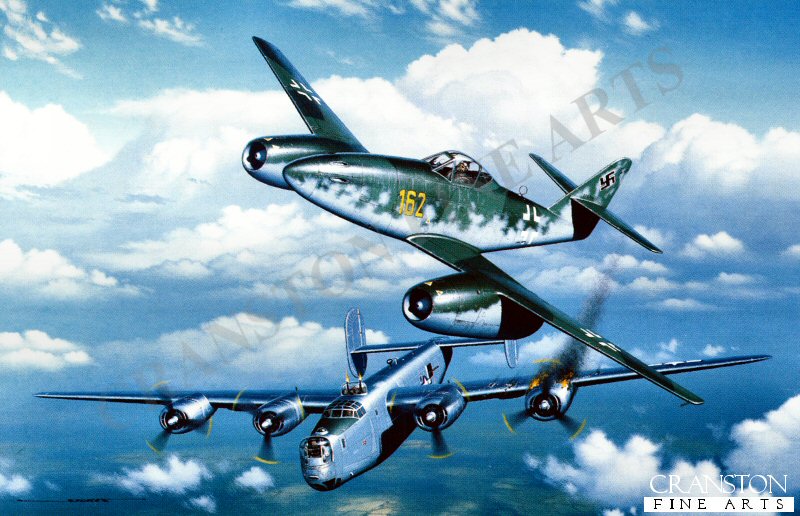- Sku:
- Vendor: Military Aviation Art Prints
Too Little Too Late by Stan Stokes.
Heinz Bar joined JG 51 in 1939 as a non-officer pilot. By August of 1940 he had become the highest scoring non-officer pilot in the Luftwaffe. Although shot down once during the Battle of Britain, Bar survived, and was later transferred to the Eastern Front. He received his commission and by the end of 1941 had chalked up 91 victories. By mid-1942, with 113 victories, he was promoted to Hauptman and made Group Commander of I/JG 77. Flying out of Sicily he participated in the siege of Malta, and later was shifted to North Africa where he obtained another 61 victories. With his health suffering, Heinz was reassigned to Germany, where he flew interception missions against the steady onslaught of Eighth Air Force bombers. With his victory total at 202, Bar was put in command of JG 3 and later III/EJG2, a unit equipped with the Me-262 jet fighter. He obtained 16 victories in March and April of 1945 while piloting the 262, making him the top jet ace of WW II. His record for victories in a jet stands until this day, having been equaled in Korea by Capt. Joseph McConnell. Bars final victory count of 220 made him the eighth highest scoring ace of all time. He was killed after the War in a flying accident. The Messerschmitt Me-262 Swallow, a masterpiece of engineering, was the first operational mass-produced jet to see service. Prototype testing of the airframe commenced in 1941 utilizing a piston engine. General Adolf Galland, who was in charge of the German Fighter Forces at that time, pressured both Goring and Hitler to accelerate the Me-262, and stress its use as a fighter to defend Germany from Allied bombers. Hitler, however, envisioned the 262 as the aircraft which might allow him to inflict punishment on Britain. About 1400 Swallows were produced, but fortunately for the Allies, only about 300 saw combat duty. While the original plans for the 262 presumed the use of BMW jet engines, production Swallows were ultimately equipped with Jumo 004B turbojet engines. The wing design of the 262 necessitated the unique triangular hull section of the fuselage, giving the aircraft a shark-like appearance. With an 18 degree swept wing, the 262 was capable of Mach .86. The 262 was totally ineffective in a turning duel with Allied fighters, and was also vulnerable to attack during take off and landings. The landing gear was also suspect, and many 262s were destroyed or damaged due to landing gear failure. Despite its sleek jet-age appearance, the 262 was roughly manufactured, because Germany had lost access to its normal aircraft assembly plants. In spite of these drawbacks the 262 was effective. For example, on April 7, 1945 a force of sixty 262s took on a large force of Allied bombers with escort fighters. Armed with their four nose-mounted cannons, and underwing rockets the Swallows succeeded in downing or damaging 25 Allied B-17s on that single mission. While it is unlikely that the outcome of the War could have been altered by an earlier introduction or greater production totals for this aircraft, it is clear to many historians that the duration of the War might have been drastically lengthened if the Me-262 had not been too little too late.
Supplied with signed and numbered certificate of authenticity.
Signed limited edition of 4750 prints.
Print size 16 inches x 11.5 inches (41cm x 30cm)
Have a question?

Too Little Too Late by Stan Stokes.


